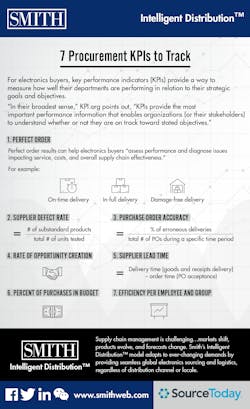A means for measuring the performance of companies, departments, business units, or even individual projects, key performance indicators (KPIs) help managers and other stakeholders understand whether progress is being made toward an intended goal. By setting KPIs centered on desired performance levels—often very specific to a business unit or department—organizations can record, track, and assess progress in a very intentional manner.
For electronics buyers, KPIs provide a way to measure how well their departments are performing in relation to their strategic goals and objectives. “In their broadest sense,” KPI.org points out, “KPIs provide the most important performance information that enables organizations (or their stakeholders) to understand whether or not they are on track toward stated objectives.
Well-designed KPIs are vital navigational instruments, KPI.org continues, giving a clear picture of current levels of performance and whether the business is where it needs to be. They all support good decision-making. “Because they help reduce the complex nature of organizational performance to a small, manageable number of key indicators, KPIs can, in turn, assist decision making—and, ultimately, help improve performance.”
7 Critical KPIs for Procurement
Accustomed to using KPIs that are focused primarily on cost savings, today’s procurement teams are now being asked to help their organizations increase revenues, stoke innovation, and improve customer service.
“In order to stay competitive in today’s hyper-paced business landscape,” Stan Garber writes in “7 New KPIs for Procurement Teams to Optimize Their Pipeline,” “CPOs and sourcing teams must reframe the procurement process and evaluate how success should be measured alongside their company’s growth goals.”
- Here are seven important KPIs that all electronics buyers can use to improve efficiency, reduce risk, and improve the organizational bottom line.
- Perfect order. “Even if you chose no other KPIs for your supply chain organization, perfect order should be considered as an absolute essential,” Benchmarking Success advises. The composite of a number of important metrics (e.g., on-time delivery, in-full delivery, damage-free delivery, etc.), perfect order results can help electronics buyers “assess performance and diagnose issues impacting service, costs, and overall supply chain effectiveness.
- Supplier defect rate. Used to evaluate a supplier’s individual quality, the KPI provides actionable insights about a supplier’s trustworthiness. “Supplier defect rates are usually measured in defects per million,” Shivasankari Bhuvaneswaran writes in “11 Essential Procurement KPIs You Can’t Ignore,” noting that supplier defect rate equals the number of substandard products divided by the total number of units tested.
- Purchase order accuracy. “Low PO accuracy hikes up operating cost,” Bhuvaneswaran points out. Measured across supply categories, buyer segments, etc., this metric will help buyers ensure that suppliers are delivering what was ordered and if it was delivered at the right time. Indicators to track include the ratio of product/service delivered outside the pre-defined service target, and the percentage of erroneous delivery over the total number of POs during a specific time period.
- Rate of opportunity creation. “Essentially, this will help define the capacity at which the team can operate with current resources,” Garber writes, “by establishing the impact on procurement’s resource capacity plan.”
- Supplier lead time. The amount of time that elapses between the time a supplier receives an order and the time when the order is shipped, this KPI is often measured in days. “Vendor lead time starts with availability confirmation and ordering and ends with the delivery of goods,” Bhuvaneswaran points out. To calculate supplier lead time, subtract order time (PO acceptance) from delivery time (goods and receipts delivery).
- Percent of purchases in budget. Based on new purchases, this KPI can “help procurement teams identify gaps in the pipeline process through their resource capacity plan,” Garber points out.
- Efficiency per employee and group. “Procurement teams can better support the global enterprise,” Garber writes, “when they can measure ultimate business outcomes next to regional performance, category, and commodity.”











